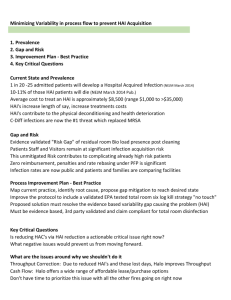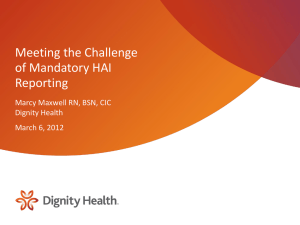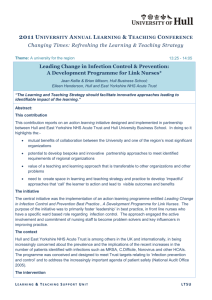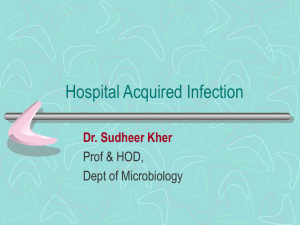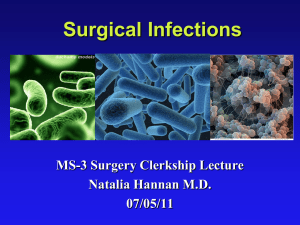knowledge and practices of infection control measures in a 450
advertisement
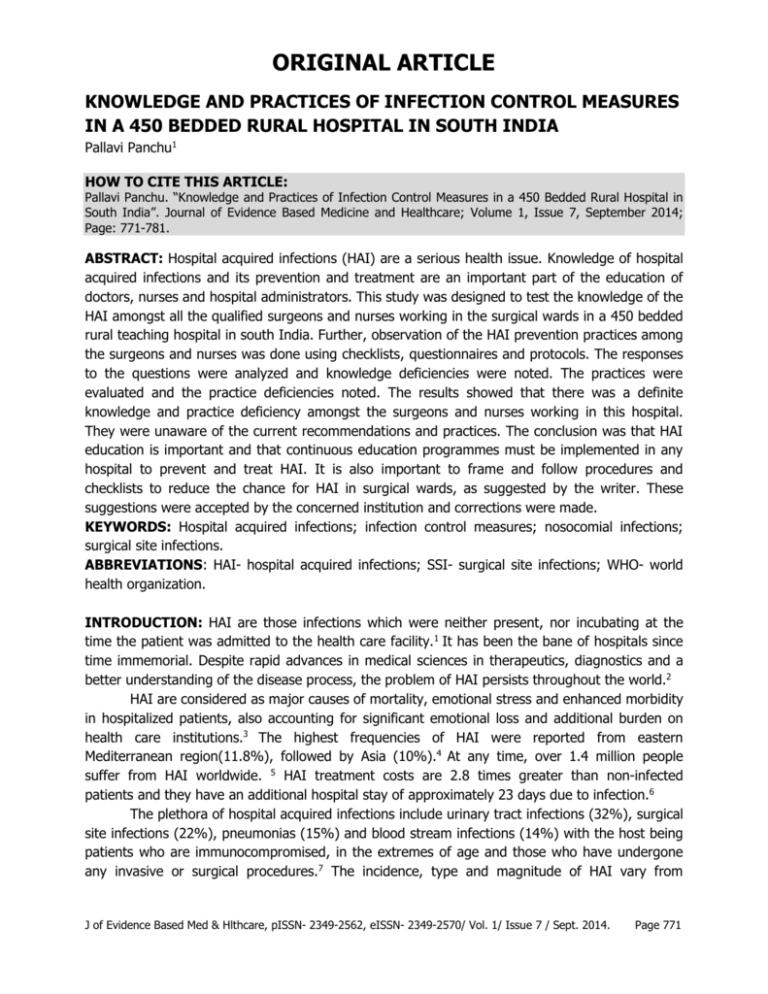
ORIGINAL ARTICLE KNOWLEDGE AND PRACTICES OF INFECTION CONTROL MEASURES IN A 450 BEDDED RURAL HOSPITAL IN SOUTH INDIA Pallavi Panchu1 HOW TO CITE THIS ARTICLE: Pallavi Panchu. “Knowledge and Practices of Infection Control Measures in a 450 Bedded Rural Hospital in South India”. Journal of Evidence Based Medicine and Healthcare; Volume 1, Issue 7, September 2014; Page: 771-781. ABSTRACT: Hospital acquired infections (HAI) are a serious health issue. Knowledge of hospital acquired infections and its prevention and treatment are an important part of the education of doctors, nurses and hospital administrators. This study was designed to test the knowledge of the HAI amongst all the qualified surgeons and nurses working in the surgical wards in a 450 bedded rural teaching hospital in south India. Further, observation of the HAI prevention practices among the surgeons and nurses was done using checklists, questionnaires and protocols. The responses to the questions were analyzed and knowledge deficiencies were noted. The practices were evaluated and the practice deficiencies noted. The results showed that there was a definite knowledge and practice deficiency amongst the surgeons and nurses working in this hospital. They were unaware of the current recommendations and practices. The conclusion was that HAI education is important and that continuous education programmes must be implemented in any hospital to prevent and treat HAI. It is also important to frame and follow procedures and checklists to reduce the chance for HAI in surgical wards, as suggested by the writer. These suggestions were accepted by the concerned institution and corrections were made. KEYWORDS: Hospital acquired infections; infection control measures; nosocomial infections; surgical site infections. ABBREVIATIONS: HAI- hospital acquired infections; SSI- surgical site infections; WHO- world health organization. INTRODUCTION: HAI are those infections which were neither present, nor incubating at the time the patient was admitted to the health care facility.1 It has been the bane of hospitals since time immemorial. Despite rapid advances in medical sciences in therapeutics, diagnostics and a better understanding of the disease process, the problem of HAI persists throughout the world.2 HAI are considered as major causes of mortality, emotional stress and enhanced morbidity in hospitalized patients, also accounting for significant emotional loss and additional burden on health care institutions.3 The highest frequencies of HAI were reported from eastern Mediterranean region(11.8%), followed by Asia (10%).4 At any time, over 1.4 million people suffer from HAI worldwide. 5 HAI treatment costs are 2.8 times greater than non-infected patients and they have an additional hospital stay of approximately 23 days due to infection.6 The plethora of hospital acquired infections include urinary tract infections (32%), surgical site infections (22%), pneumonias (15%) and blood stream infections (14%) with the host being patients who are immunocompromised, in the extremes of age and those who have undergone any invasive or surgical procedures.7 The incidence, type and magnitude of HAI vary from J of Evidence Based Med & Hlthcare, pISSN- 2349-2562, eISSN- 2349-2570/ Vol. 1/ Issue 7 / Sept. 2014. Page 771 ORIGINAL ARTICLE hospital to hospital and is estimated to be around 10 % of all hospital admissions.1 Given the prevailing conditions in the hospital in developing countries, this is likely to increase. One of the cardinal principles of hospital care is that it should cause no harm to the patient. Health care givers and employees alike are accountable for their part in ensuring a safe environment for the staff, patients and visitors. The purpose of this study was to assess the knowledge of the surgeons and nurses working in the surgical departments regarding their knowledge in measures to control HAI and whether this knowledge translated into correct practices. METHODOLOGY: This study was undertaken in a 450 bedded rural teaching hospital, Sree Mookambika Institute of medical sciences, Kanyakumari district in south India. It was approved by the institution ethics committee. This was an observational study and involved testing the knowledge regarding HAI and its control and observing the practices of HAI prevention among the surgeons and nurses working in the surgical departments. All surgeons (general surgeons, orthopedic surgeons, gynecologists, ENT and ophthalmologists), eleven in number working in this hospital were included in the study because they perform surgeries and other invasive procedures which contribute to the occurrence of HAI. The surgeons were all qualified in their specialties and directly involved in patient care. All nurses (twenty eight in number) working in the above mentioned departments, in the operation theatres and post-operative wards were also included. The nurses also were registered with the nursing council of India. METHODOLOGY: The surgeons and nurses were each given different questionnaires. The questionnaire in this study has been designed to test the person’s knowledge of the fundamentals in the various essential parameters of infection control. The established World Health Organization guidelines2 have been used as the core knowledge to be tested and these guidelines are usually found discussed in both nursing and medical textbooks commonly recommended to the participants of this study. The questions pertained to the causes, etiology, modes of transmission, patient susceptibility, methods of hand washing, disposal of waste, methods of prevention and treatment of HAI. Scores were given to the correct answers and the total score calculated. Observation practices were done using the following: 1. Surgical site infection prevention bundle, Health Protection, Scotland 8 2. Infection control procedural surveillance checklist- Grampiens Regional infection control group. 9 RESULTS: Scores were given to the correct answers in surgeons and nurses. The total score of each participant the participant has in his/ her own field. The percentages were calculated and the results graphically expressed. the questionnaires answered by both was tabulated against the experience of wrong responses for each question An observation of the practices for J of Evidence Based Med & Hlthcare, pISSN- 2349-2562, eISSN- 2349-2570/ Vol. 1/ Issue 7 / Sept. 2014. Page 772 ORIGINAL ARTICLE prevention of HAI was done using the guidelines and checklists in each department and the deficiencies were noted and are listed below in general. DISCUSSION: Infection control is a top priority in hospital management. Nosocomial infections are one of the leading causes of death.9 History of infection control shows that even a single control measure can have dramatic results and benefit the patients and healthcare providers alike.10 Some of the measures have been based on observation while others on scientific evidence, but it is now important to have a rational infection control policy based on evidence based guidelines. The organisms may have changed and so have the antibiotics, but the principles of war against infections remained the same. The results of this study show that irrespective of experience, both doctors and nurses show deficiency in the knowledge of infection control measures (figures 1 & 2). An analysis of the results given to the questions addressed to doctors reveal that the question pertaining to components of surgical site infection, question no 10 (annexure 1, figures 3 & 4) elicited the maximum wrong answers (91% answered wrong). Post- operative antibiotic therapy given for 24 hours is as effective as a prolonged post-operative antibiotic therapy is the current accepted guideline. The question based on sources of HAI (question no 2) falls under the category of second highest wrong answer (82%). This lack of awareness can be corrected by education. Questions related to definitions and causative organisms (73%), questions based on practice of sharp disposal in hospitals (73%), also elicited wrong answers. Questions pertaining to invasive procedures which are a source of HAI (73%) and surgical prophylaxis post 24 hours were wrong (55%). All this indicates that knowledge and awareness of HAI need to be clarified and reiterated. An analysis of results given to the questions by the nurses (annexure 3, figure 5) (reveal that the commonest wrong responses were to the questions related to sterilization procedures adopted (86%), air conditioning in operation theatres (63%), measures of prevention and transmission of HAI (55%), and importance of hand washing (50%). The fundamental nature of these questions indicate that education and training are deficient and must be corrected to make the nurses aware of the principles and motivate them to follow these principles in day to day care of the patients. An observation of the practices shows that the following are not as per the recommendations and guidelines. 1. Hair removal preoperatively with a razor. 2. Glycemic levels are unregulated intra-operatively. 3. Alcohol based hand washes are not utilized. 4. Good hand washing posters and induction programmes are not present. 5. ‘Non reuse policy’ not present. 6. No hand moisturizer available. 7. No procedure to notify the higher authorities about HAI. 8. New nurses do not have an induction programme for standard precautions. J of Evidence Based Med & Hlthcare, pISSN- 2349-2562, eISSN- 2349-2570/ Vol. 1/ Issue 7 / Sept. 2014. Page 773 ORIGINAL ARTICLE 9. Protective clothing is not worn when appropriate. 10. Theatre mops are reused. 11. Improper care of multi-use vials. 12. Disposable gloves are not used for urine bag emptying. 13. Inadequate dressing supply and disposal. 14. Improper use of instruments during wound dressing. These deficiencies indicate a need for an infection control committee, infection control policy and an infection control training programme for nurses and doctors alike to change the existing flaws and to follow WHO guidelines. All attempts must be made to prevent HAI as eradication is not possible. By understanding the attitude and knowledge of the doctors and nurses, the lacunae can be corrected. The hospital administration has shown the necessary will to change and correct the deficiencies which are perhaps the most important step in implementing corrective measures. The scene today: infection control committee has been set up and regular meetings are held. Induction classes are taken for the nurses and doctors have to attend continuing medical education programmes regarding HAI. There are surprise checks from the hospital administration which goes a long way to ensure adherence to the WHO guidelines. A follow up study is required to assess the improvement in knowledge and practices regarding HAI amongst the health care givers, as this is a cross sectional study at a particular point in time. The study emphasizes that in spite of training and experience a reiteration of current developments in HAI is important and implementation is the key to prevention. ACKNOWLEDGEMENTS: Our sincere thanks to the management and staff of Sree Mookambika Institute of Medical Sciences for giving me the permission and cooperation to carry out this study. In addition we would like to thank Dr. V. Narendranath, associate professor, M. S. Ramaiah Medical College, Bengaluru for his guidance in helping me undertake this study. We would also like to extend my thanks Mrs. Naga Saritha Kolli, lecturer in statistics, NRI medical college for helping me generate the tables and graphs. REFERENCES: 1. Benson AS. Control of communicable diseases manual. 16th ed. Washington: American Public Health Association; 1995. P 94-101. 2. Ducel G, Fabry J, Nicolle L. Prevention of Hospital Acquired Infections, A Practical Guide.2nd ed. World Health Organization; 2002.P 9-10. http: //www.who.int/emc 3. McCulloch J. Infection control- Science and Practice. London: Whurr Publishers Ltd; 2000. P.39 4. Mayon-White RT, Ducel G, Kereselidze T, Tikhomirov E. An international survey of the prevalence or hospital acquired infection. J Hosp Infect.1998; 11 (supplement A): 43-48. 5. Tikhnmirov E. WHO programme for the control of Hospital Infections. Chemiotherapia.1987; 6: 148-151. J of Evidence Based Med & Hlthcare, pISSN- 2349-2562, eISSN- 2349-2570/ Vol. 1/ Issue 7 / Sept. 2014. Page 774 ORIGINAL ARTICLE 6. Esatoscu A, Agirbas I, Rifibi O, Celik O, Celik Y. additional cost of hospital-acquired infection to the patient: a case study in Turkey. Health Serv Manage Res 2006; 19: 137-143. 7. Zitterkopf NL. The advantages of molecular diagnostics in the surveillance of health care associated infection. Lab Medicine 2008; Oct 10 (39): 623-625. 8. Surgical site infection bundle (Health protection Scotland) www.hps.sco.nhs.uk/basic/ic/SSIpreventionbundle.aspx last accessed on 31.3.2011 9. Grampians infection control check list.www.health.nic.gov.au/ideas/infcon/rural/grampians last accessed on 31.3.2011 10. Wenzel RP. The economics of nosocomial infections. J Hosp Infect.1995; 31: 79-87. 11. Alexander J. The contributions of infection control to a century of surgical progress. Annals of surgery 1985; 201 (4): 423-428. Figure 1 Class interval age average score 0-3 years 22 16 4-7 years 2 15 8-10 years 3 15 J of Evidence Based Med & Hlthcare, pISSN- 2349-2562, eISSN- 2349-2570/ Vol. 1/ Issue 7 / Sept. 2014. Page 775 ORIGINAL ARTICLE 11-13 years 0 0 14-17 years 0 0 18-20 years 1 17 Figure 2 Figure 3 Figure 4 J of Evidence Based Med & Hlthcare, pISSN- 2349-2562, eISSN- 2349-2570/ Vol. 1/ Issue 7 / Sept. 2014. Page 776 ORIGINAL ARTICLE Figure 5 ANNEXURE-1 QUESTIONAIRE FOR DOCTORS KNOWLEDGE ASSESSMENT PLEASE TICK THE SINGLE BEST OPTION 1. A person acquires hospital acquired infection – a. during hospitalization c. before admission b. after discharge d. a & b 2. Hospital acquired infections are the result of: a. self-infection c. environmental infection b. cross infection d. all of the above 3. Which is the most important cause of hospital acquired infection? a. staph aureus b. coliforms c. E coli d. pseudomonas J of Evidence Based Med & Hlthcare, pISSN- 2349-2562, eISSN- 2349-2570/ Vol. 1/ Issue 7 / Sept. 2014. Page 777 ORIGINAL ARTICLE 4. The risk of infection is increased in hospitals by all EXCEPT: a. dry sweeping b. repeated sorting out of linen at various places c. ineffective air conditioning d. mechanized floor cleaners 5. Sterilization is a process of a. killing microorganisms c. both a & b b. killing spores d. none of the above 6. Air changes per hour in OT should ideally be a. 10-12 times/hour c. 28-30 times/hour b. 16-18 times/hour d. 58-60 times/hour 7. Name a category of patients who are at a high risk of acquiring nosocomial infections. a. Immune compromised patients b. patients with multiple trauma c. patients with burns d. organ transplants e. all of the above f. a & b 8. What is the minimum effective contact time for surgical scrub? a. 1-2 mins b. 2-3 mins c. 3-5 mins d. 5-7 mins 9. The correct method for needle disposal isa. detach needle from the syringe and throw in a dustbin b. Don’t detach needle from syringe and throw both in a dustbin. c. detach needle from syringe and put in antiseptic solution d. Don’t detach needle from the syringe and put in antiseptic solution. 10. The following are the components of surgical site infection prevention EXCEPT: a. Short preop stays in the hospital b. avoiding shaving of hair c. post operative antibiotic therapy for 72 hours d. Antibiotic prophylaxis within 1 hour prior to incision. J of Evidence Based Med & Hlthcare, pISSN- 2349-2562, eISSN- 2349-2570/ Vol. 1/ Issue 7 / Sept. 2014. Page 778 ORIGINAL ARTICLE ANNEXURE 2 Indicate whether true or false (T- true; F- false) 1. Most surgical site infections (SSIs) are caused by endogenous sources of bacteria The purpose of using surgical antimicrobial prophylaxis is to reduce the microbial 2. burden of intraoperative contamination 3. Hands must be washed each time when the gloves are removed or changed Ideally, surgical prophylactic antibiotics should be timed such that the optimal 4. concentration is in the serum/tissue at the time of the incision. A single dose of quinalone is generally considered to be a good choice of drug for 5. elective clean procedures. Continuing the surgical prophylaxis antimicrobial agent past 24 hours after surgery 6 has not been 7. Endotracheal intubation is a high risk invasive procedure for HAI The single most important measure to prevent hospital acquired infection is hand 8. wash 9. Tight control of perioperative blood glucose levels may lead to better SSI outcomes. 10. The commonest causative organism for urinary tract infection in HAI is pseudomonas The most effective time for antibiotic administration is within 3 hour prior to skin 11. incision. 12 Moisture reduces the transmission of microorganisms Do you feel that this questionnaire has been useful to you? ---------------- ANNEXURE- 3 QUESTIONAIRE FOR NURSES Please indicate whether true or false: SL. NO QUESTION 1. Hands must be washed each time when the gloves are removed or changed 2. Endotracheal intubation is a high risk invasive procedure 3. 4. T F The single most important measure to prevent hospital acquired infection is hand wash The commonest causative organism for urinary tract infection is pseudomonas J of Evidence Based Med & Hlthcare, pISSN- 2349-2562, eISSN- 2349-2570/ Vol. 1/ Issue 7 / Sept. 2014. Page 779 ORIGINAL ARTICLE 5. Rings, and bangles can be worn during hand washing 6. Patients receiving immunosuppressive therapy are more susceptible to hospital acquired infections 7. 2% gluteraldehyde is effective for 14 days 8. Moisture enhances the transmission of microorganisms 9. 10. 11. 12. 13. 14. 15. If a person does not show signs and symptoms he cannot transfer the disease Ineffective air conditioning in OT complex decreases the chances of air borne infections The minimum effective contact time for surgical scrub is 3-5 minutes The correct method of disposal of used syringes is to separate the needle from the syringe and to dispose both in the dustbin. Before injection, the skin of the patient is cleaned with cidex Staphylococcus aureus is the organism responsible for hospital acquired infections. Hospital acquired infections cannot be prevented by health care workers 16. Wound dressing should be done using ‘no touch ‘ technique 17. Soiled linen and waste can be handled without gloves 18. Nurses are not part of the infection control team 19. A patient may acquire hospital acquired infection after discharge from the hospital 20. Sterilization procedure cannot kill spores Do you feel that this questionnaire has been useful to you? --------------------------- J of Evidence Based Med & Hlthcare, pISSN- 2349-2562, eISSN- 2349-2570/ Vol. 1/ Issue 7 / Sept. 2014. Page 780 ORIGINAL ARTICLE AUTHORS: 1. Pallavi Panchu PARTICULARS OF CONTRIBUTORS: 1. Associate Professor, Department of Physiology, IQ City Medical College, Survapur. NAME ADDRESS EMAIL ID OF THE CORRESPONDING AUTHOR: Dr. Pallavi Panchu, Associate Professor, Department of Physiology, IQ City Medical College, Survapur, B Zone, Durgapur, West Bengal – 713206, India. E-mail: drpallavipanchu@gmail.com Date Date Date Date of of of of Submission: 08/09/2014. Peer Review: 09/09/2014. Acceptance: 09/09/2014. Publishing: 13/09/2014. J of Evidence Based Med & Hlthcare, pISSN- 2349-2562, eISSN- 2349-2570/ Vol. 1/ Issue 7 / Sept. 2014. Page 781
